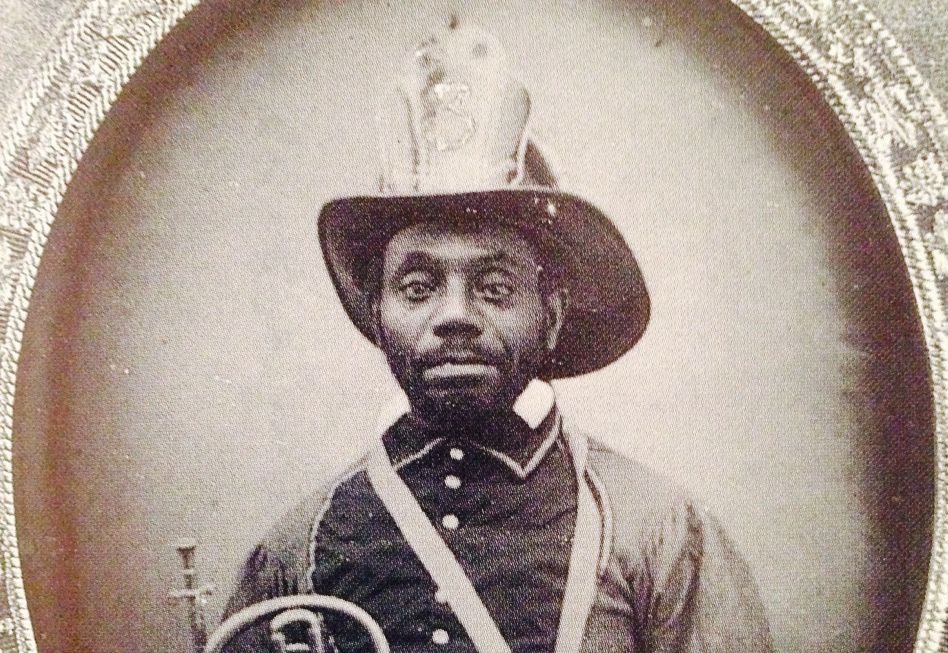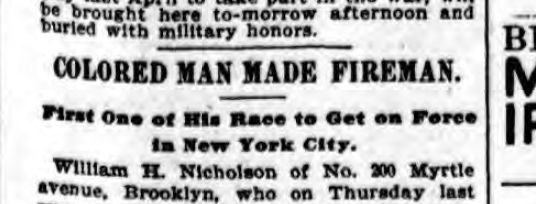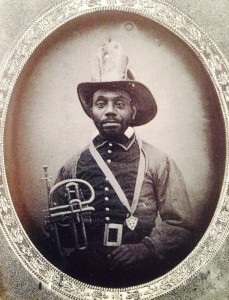COULD COLORED MEN PUT OUT FIRES? (1898)

Brownstone Detectives investigates the history of our clients’ homes.
The story you are about to read was composed from research conducted in the course of one of those investigations.
Do you know the history of YOUR house?
********************************************************************************************************************************
In 1898, a Brooklyn – and New York City – “first” occurred when Fire Commissioner John Jay Scannell assigned the first black man to serve in the Fire Department in Brooklyn.

William H. Nicholson, of No. 200 Myrtle Avenue, was a 29-year-old former cement tester who had been born in Virginia. He would become, in a number of ways, the precursor to the many first blacks to be “allowed” to integrate society’s historically “white” institutions in the century to follow.
While, in 1891, Wiley G. Overton, another “colored man,” had been the first to be appointed as a patrolman on the Brooklyn police force, Nicholson, as a fireman, was still entering into a conflagration of his own.

Patrolman Overton had found his existence on the force to be terminally difficult. Assigned to patrol the Brooklyn “colored district,” he had been transferred around to several precincts because no white officer would sleep in the same dormitory with him. His very presence in every station house had “caused trouble.” Finally, after being subjected to all sorts of “annoyances,” Overton had been “practically hounded from the force” a few years after his appointment.
And it was likely that Nicholson knew this.
Now, Nicholson had become the Fire Department’s unofficial test case for “colored integration.” The pressure was likely almost unbearable, as all eyes were on the man to see if a “colored” possessed the same “stuff” that a white man had to be a fireman. The slurs and the racial comments had to have been unavoidable. But Nicholson was determined to make it a go and, if the pressure was too much, be satisfied with a few years on the force.
After all, as one newspaper noted at the time, “there is no law to deprive his race from the right of such an appointment.”
 The history of black firemen actually goes back at least to pre-Civil War days when black firemen served in the Fire Department in New Orleans, Louisiana, around 1817. This significant event took place more out of a reaction to a lack of men available to put out fires, though, than from some progressive Southern desire for racial equality.
The history of black firemen actually goes back at least to pre-Civil War days when black firemen served in the Fire Department in New Orleans, Louisiana, around 1817. This significant event took place more out of a reaction to a lack of men available to put out fires, though, than from some progressive Southern desire for racial equality.
But it was a start.
As one might guess, Nicholson “was never called upon to do any fire fighting, except on the Fourth of July, when all men in the department are held ready for emergencies.” How would it have looked if a black man had, given the chance, risen to the occasion and outshone his white counterparts? As an answer to that question, Nicholson would be given duties that had little to do with putting out fires.

Assigning blacks, though, to the menial work in the force was going to be a practice that would take a long time to break. The first “coloreds” appointed to the Brooklyn police force were given the sort of “separate but equal” title “doormen.” They did not perform police work, but assisted in administrative duties at the police station, assisting with criminals and such. (The title would eventually be done away with in the 20th century.)
Nicholson did make the papers, though, soon after his appointment when, as a “negro probationary fireman,” he “had a narrow escape” while transferring a new horse, accompanied by a horse trainer from the department, from one station house to another. Just after the two men had crossed the Third Avenue Bridge over the Harlem River, they came upon a trolley car. Both horses became frightened by the trolley car, one of them landing in the gig that Nicholson was driving, “throwing both men to the ground in front of the approaching car.” The car stopped just in time and the horses ran further up the avenue at a gallop.

After his probationary period ended, Nicholson was assigned to Fire Headquarters at Jay Street in Brooklyn, where he performed tasks around the fire house – likely dealing with the horses.
There is little mention of Nicholson in the papers until December of 1911 when he would retire on a $700 pension. Appearing before a medical examiner it was found that he was suffering from heart disease. And so, like the many horses that he had tended for the Fire Department throughout his 12-year career, Nicholson would be “Put out to pasture,” after he was found to be no longer able to perform his duties as a fireman.
On 4 January, a local newspaper noted that a number of Nicholson’s friends presented him with a “token of their regard for him as the only colored fireman in New York.” Pride must have swelled deep in the hearts of Nicholson’s family and friends as he had not only joined the Fire Department, but he had stayed through what was certainly many trials and indignities – a testament to him as a person, and a testament, in many peoples’ eyes, to his race.
Perhaps his dedication to the department changed some peoples’ minds. Perhaps it was one of the first of many cracks in that glass ceiling that was to come. We may never know for certain. What we can be certain of, though, is that Nicholson’s service gave many blacks in Brooklyn a reason to feel a sense of fulfillment and dignity in who they were – even if it was through the life of another human being.
Unfortunately, though, for Nicholson, he was only able to enjoy his retirement for a mere month after leaving the department. His heart disease must have been acute, for 2 1/2 weeks later, Nicholson would be dead.
The legacy that he would leave, though, would live on.
The first colored Brooklyn fireman was survived by his widow, two sons, his mother, and one brother.
———————————————————————————————————————–
 Brownstone Detectives is an historic property research agency. Our mission is to document and save the histories of our clients’ homes. From our research, we produce our celebrated House History Books and House History Reports. Contact us today to begin discovering the history of your home.
Brownstone Detectives is an historic property research agency. Our mission is to document and save the histories of our clients’ homes. From our research, we produce our celebrated House History Books and House History Reports. Contact us today to begin discovering the history of your home.